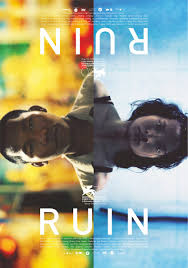
RUIN
Australia/ Cambodia, 2013, 88 minutes, Colour.
Sang Malen, Rous Mony.
Directed by Michael Cody, Amiel Courtin- Wilson.
Ruin won prizes at the Venice film Festival in 2013. It has had limited release.
Director, Amiel Courtin- Wilson has made several interesting films, collaboration with groups and amateur actors, especially his drama, Hail, collaborating with a former prisoner and dramatising his life story and what happened when he was released from prison.
This time, Courtini- Wilson and his co-director, Michael Cody, have travelled to Cambodia, working with amateurs again, using the Khmer language except for one character speaking in English, a venture which had them observing Cambodian life, many of the squalid aspects of life. The film was supported financially by Australian funding agencies.
For the first couple of minutes, impressionistic colours and movement pervade the screen until the camera moves down into the city of Phnom Penh, following the central character, Phirun, as he tries to work in a factory, the butt of attacks by fellow workers. Then there is a transition to a dingy room, a brothel room where a pimp is severely berating, physically and verbally, a young prostitute, Sovanna.
When each of the characters escapes their oppressive situation, they walk down a market Street together, gradually relating to each other, helping each other – which leads to a journey that could be partly their ruin, but is a journey with some degree of hope.
The film is very dark – and often visually dark as the two move through the countryside, come to a river, cross the river and find some children and accepting adults as well as some peace – but after some violent encounters including a killing and Sovanna having to deal with a sexually aggressive client.
For many audiences, the film would be something of an experiment, an invitation to go into the poor areas of the Cambodian city as well as into the back blocks, challenging people to think of the oppression of so many millions in Asia.
1. The impact of the film? Visuals? Impressionistic? The narrative?
2. Filmmakers, this style, interests, the use of the Khmer language?
3. The locations, the observation of Cambodian life by outsiders? Identifying with the characters? The challenge?
4. The title, as experienced by the Phirun and Sovanna? A world of ruin – and possible recovery?
5. An Australian- Cambodia co-production, the Australian presence In Cambodia, Australian finance, technical aspects?
6. The long visual and impressionistic introduction and setting the tone?
7. Phnom Penh, the city, squalid, the factories and their interiors, the brothel and the room, the toilet? The markets, the fishmarket, the streets, the boats? The musical score?
8. Phirun’s story, his appearance, in the factory, wanting work, the attack, his wanting respect, violence, his leaving?
9. Sovanna story, the harshness of the pimp, brutality, physical and verbal abuse, humiliation? The talk about her clients? The toilet, the water, the people arriving, her running?
10. On the road, the city street, survival, the rooms, fear of being moved on, being together, the mat for her sleeping, offering the food?
11. The development of the bond between them, help, dependency, continually moving?
12. The journey, going out of the city, the interiors of the hearts, surviving?
13. The violence, the man with his throat slit? Sovanna and the client, his talk, the sexual activity – and her ultimately killing him?
14. Going on the boat, the boatman, the remote location, the children, the family, the celebration?
15. Peace, security? The final image of the two profiles – and the vision of the stars?